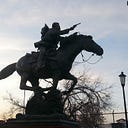Monumental People
The Mexican Revolution was plagued with different factions all fighting for power. Two of these factions were the Constitutionalist and the Conventionist. The Constitutionalist were made up of mostly middle class and an idea of “A Mexico for Mexicans”. Led by Obregon and the more independent leaders like Pancho Villa or Emiliano Zapata. The coventionist were a diverse group also but they lacked some strong leaders. This and the fact that the Constitutionalist were much more militarily inclined, and I would argue had a better reason to win, were able to prevail. Samuel Brunk states that “ they fought, in sum, for conditions crucial to the preservation of their rural culture” (Brunk, 447–448). The Constitutionalist had a essential reason to fight and it was almost do or die. However, they were then plagued by problems after their victory. Before and after the 1917 constitution the Constitutionalist were still wreaked with factionalism. The problem that they were facing was that even though they were fighting together, they all had a different reason to fight. Some were fighting for agrarian and rural people rights. Some were also fighting for political reform and progressive policies. These caused many different factions to arise, most of which could just not seem to get along. When Alvaro Obregón came to power in the early 20’s he had some work to do. He first focused of consolidating his power. This was essential because many leaders before him were unable to do so and were then forced to fight for their position. Obregon worked to please the agrarians by giving them land and improving their quality of life. He began investing in the infrastructure and domestic production in Mexico. This was huge because he was not selling the people to foreign investors. Also Obregon put the correct people in positions of power rather than giving it to the wealthy or his friends. In the Benjamin reading on Monuments, “Obregon unveiled a monument in Merida, Yucatan, during his presidential campaign in the spring” (Benjamin, 125), this goes to show that even in his later years he was still trying to consolidate power. Mexico had a long history of power struggles, and distrust in the government so Obregon had a long way to go when it came to consolidating his power. I would argue that his election did not bring the close of the Revolution but his administration did eventually. As previously stated, Obregon had a lot of enemies and one of those as time. He was able to identify his problems and solve them in efficient manner. He did not do everything all at once but did the important things first such as getting the people of his side, and then moved on to things such as investing and improving the economy.
With his strategic methods and winning over the hearts of the People he was able to bring a close. Benjamin also states that “ The greatest single monument to an individual revolutionary was dedicated to Alvaro Obregon(Benjamin, 126)” this goes to show that Obregon was loved by all because Benjamin also describes all of the other amazing statues dedicated to the like of Zapata, Carrillo Puerto and even Madero, but none top Obregon’s.
